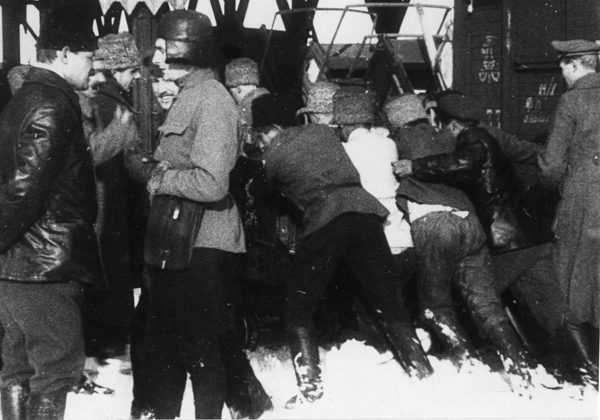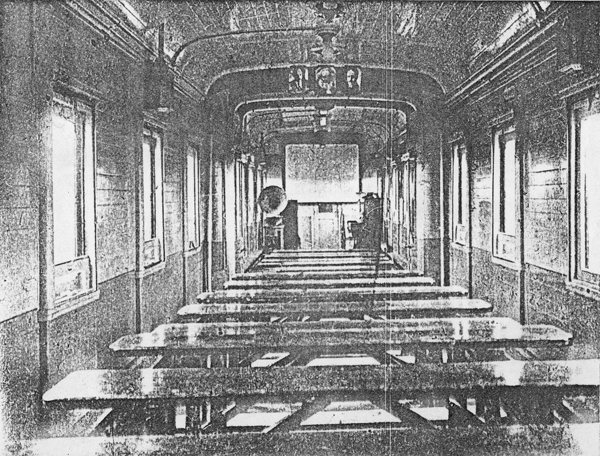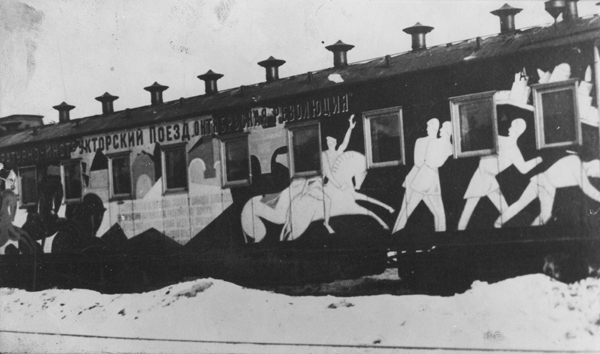Soviet Agit-Trains from the Vertov Collection of the Austrian Film Museum
By Adelheid Heftberger
 Agit-train October Revolution / Vertov-Collection, Austrian Film Museum
Agit-train October Revolution / Vertov-Collection, Austrian Film Museum
Since the beginning of the post-revolutionary era, Soviet political leaders employed art – specifically cinema, for propaganda and agitation. State powers and the Communist Party dispatched trains and steamboats to the peripheries of the vast Soviet territory to spread their political message and to educate the (mostly) illiterate populace. Agit-trains enabled political leaders to both literally and figuratively travel the front lines and distribute propaganda literature to civilians and soldiers of the Red Army fighting in the first Russian Civil War (1917-1923). Agitational bureaus (agitpunkty) were established at major railway stations, where libraries, lecture halls, and theatres were opened. Cinema was considered a very powerful instrument in such agitational efforts, and large numbers of films – or agitki, were produced expressly for exhibition on “agit-trains.”[1]
 Agit-train October Revolution / Vertov-Collection, Austrian Film Museum
Agit-train October Revolution / Vertov-Collection, Austrian Film Museum
October Revolution was the most active of all “agit-trains,” serving 12 tours of duty from 1919-1920. In two months alone, it screened cinema to over 100,000 people in 97 screenings.[2] Typically 16 to 18 cars in length, other agit-trains included the Red East, Soviet Caucasus, and Red Cossack. All were equipped for any possible propaganda need, each with its own broadcast radio station, internal telephone system, mobile camera shop, printing press, and newspaper office.[3] As surviving photographs show, agit-trains were decorated with graphical or satirical paintings, which playfully reflected the names of the trains and the places where they were headed.[4] One Russian poster, promoting the trains in 1920, reads:
From far-away this train has brought us valuable presents. Hurry up, comrades! This train won’t be staying long. You must realize that a truthful and intelligent book will light your path in the struggle for a better future.”[5]
 Dziga Vertov on the agit-train October Revolution in 1920, talking to staff / Vertov-Collection, Austrian Film Museum
Dziga Vertov on the agit-train October Revolution in 1920, talking to staff / Vertov-Collection, Austrian Film Museum
After numerous tours of duty on agit-trains, including several aboard October Revolution, a young Dziga Vertov was enlisted by the war office of the All-Russian Central Executive Committee to manage all agit-train film and photo divisions.[6] (Vertov can be seen in the foreground, above, in a photo from 1920, wearing a leather hat and speaking with comrades.)
 Screening room inside agit-train October Revolution / Vertov-Collection, Austrian Film Museum
Screening room inside agit-train October Revolution / Vertov-Collection, Austrian Film Museum
Inside the cinema cars of agit-trains, (October Revolutuion screening room is seen above), films were screened with musical accompaniment – either piano, or gramophone records. Outdoor film screenings were initially silent; however, Vertov soon began offering oral explanations and commentary for the audience – a task he viewed as essential to the communicative act:
I had to provide explanations of the films for nearly every audience. Most of the films were made crudely and carelessly, and an average viewer seeing them for the first time cannot understand them completely. Solving the riddles with the glosses made the film understandable even to the nearly illiterate.[7]
Vertov kept daily registers of the films screened, and his diary from the period describes his mobile exhibition journeys:
Comrade Lenin attached great significance to the use of film in the work of the agitational trains and steamers. And so on January 6, 1920, I leave with Comrade Kalinin for the southeast front. I take films with me. Including THE ANNIVERSARY OF THE REVOLUTION (1918) [Vertov’s first film]. We study the new viewer. We screen that film at all the train stops and carry it to urban movie theatres. At the same time, we shoot.[8]
 Agit-train October Revolution / Vertov-Collection, Austrian Film Museum
Agit-train October Revolution / Vertov-Collection, Austrian Film Museum
As he suggests, Vertov’s work on agit-trains extended to the creation of 43 issues of the Kinondelja (Kino-Week) series of newsreels. By spring 1922, Vertov began devoting his efforts more centrally to his noted Kinopravda newsreel series, but the years of itinerant exhibition experience left him a major proponent of Soviet mobile cinema as propaganda exhibition diversified to include mobile film trucks, and temporary collapsible outdoor venues which held greater flexibility than those on rails.
NOTES
1. Peter Kenez, The Birth of the Propaganda State: Soviet Methods of Mass Mobilization, 1917–1929 (Cambridge: Cambridge University Press, 1985), 59.
2. Exhaustive statistics can be found in Lidija Vladimirovna Maksakova’s Agitpoezd 'Oktjabr’skajaRevoljucija‘ 1919–1920 (Moskva: Akad.nauk. SSSR, 1956) – an indispensible study that provides vast numeric documentation regarding agit-train and agit-steamboat journeys.
3. Although rumors of mobile film processing labs persist, no evidence of this has been uncovered to date.
4. For colorful images of the trains, see: V.P. Tolstoj (ed.), Agitmassovoe Iskusstvo Sovetskoj Rossii: Materialy i dokumenty. Agitpoezda i agitparochody. Peredvižnoj teatr. Političeskij plakat. 1918–1932, 2 vols. (Moskva: Iskusstvo, 2002). David King’s Red Star over Russia: A Visual History of the Soviet Union from the Revolution to the Death of Stalin (New York: Abrams, 2009), provides many details connected to train decoration and cites Vjačeslav Polonskij’s tome Russkij revoljucionnyj plakat (The Russian Revolutionary Poster) from 1925, which argues that the language and style used on agit-trains was very similar to the Russian Petruška theatre.
5. King, ibid.
6. See the related document “Confirmation no. 11001,” in Thomas Tode and Barbara Wurm (eds.), Dziga Vertov: The Vertov Collection at the Austrian Film Museum (Vienna: Synema, 2006), 218. A selection of documents has been published there, while the whole collection is searchable online on the Austrian Film Museum’s website.
7. John MacKay, Dziga Vertov: Life and Work (forthcoming). MacKay quotes RGALI f. 2091, op. 2, d. 386, 1. 19ob (from report to Grigorij Lemberg).
8. Dziga Vertov, “O moej ljubvi k živomu čeloveku (About Love for the Living Person),” 1958, cited in Annette Michelson (ed.), Kino-Eye. The Writings of Dziga Vertov (Berkeley: University of California Press, 1984), 151.
ABOUT THE AUTHOR
Adelheid Heftberger is an archivist and researcher at the Austrian Film Museum in Vienna since 2007. She holds M.A. degrees in Slavic studies and comparative literature from the University of Innsbruck in Austria. Among other responsbilities she serves as curator of the Film Museum's Dziga Vertov Collection. She is currently writing her Ph.D. thesis on data mining and the visualization of filmic structures in the films of Dziga Vertov.
